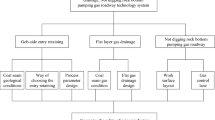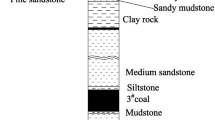Abstract
A large amount of waste rock is generated during thin seam coal mining operations underground. The waste rock material stacked on surface also adds to the environmental pollution. So it is important to reduce the amount of waste rock by exploring gainful utilization methods. This paper deals with an investigation undertaken to develop an alternate gob filling material in laboratory and evaluating its efficiency numerically as well as in field. A coal–waste rock separation system and a roadway layout system were designed, and a new technique of fully-mechanized goaf-side entry retaining and goaf filling back hydraulic supports was proposed. These methods helped realize the goal of green mining, which was featured by waste rock consumption in nearby region without any need to be elevated to ground surface. This study demonstrated that the two proposed mining methods, namely, caving mining method and mining with filling method, differed in mechanical environments where roadside filling body was located, deformation, and failure scope. The maximum principal stress concentration degree near the roadside filling body for caving mining method was high with a maximum value of 42.5 MPa because of key rock blocks in overburden. As a result, the surrounding rock of roadside filling body was severely deformed with a maximum displacement of 1117 mm. The entire roadside filling body moved toward the inside roadway and experienced plastic failure. After goaf filling, filling bodies in goaf, roof and floor strata, and roadside were combined to form an entire withstanding deformation. The motion space of overburden rock was limited, the adjustment range of surrounding rock stress near the roadside filling body was narrowed, the maximum principal stress decreased to 29.5 MPa, and the main roof did not rupture. Accordingly, the deformation of surrounding rocks of the roadside filling body was small, the maximum displacement of roof and floor was 457 mm, and the roadside filling body did not experience plastic failure. The study results enrich goaf-side entry retaining theory in thin coal seam and mechanized filling technology and provide a theoretical foundation for thin coal seam mining with difficulty in waste rock treatment.













Similar content being viewed by others

References
Alejano LR, Rodríguez-Dono A, Veiga M (2012) Plastic radii and longitudinal deformation profiles of tunnels excavated in strain-softening rock masses. Tunn Undergr Space Technol 30(4):169–182
Bai JB, Zhou HQ, Hou J (2004) Development of support technology beside roadway in goaf side entry retaining for next sublevel. J China Univ Min Technol 33(2):183–186
Chen S (1994) Calculation of additional stresses in soil produced by infinite long ladder-shaped distribution load. Suzhou Instit Urban Constr Environ Protect 7(3):29–32
David RG, Rafael J (2012) A probabilistic extension to the empirical ALPS and ARMPS systems for coal pillar design. Int J Rock Mech Min Sci 52:181–187
Huang YL, Zhang JX, Zhang Q et al (2011) Technology of goaf-side entry retaining on its original position in fully mechanized coalface with solid material backfilling. J China Coal Soc 36(10):1624–1628
Li LC, Yang TH, Liang ZZ et al (2011) Numerical investigation of ground water outbursts near faults in underground coalmines. Int J Coal Geol 85(3):276–288
Mark C, Gale W, Oyler D, Chen J (2007) Case history of the response of a longwall entry subjected to concentrated horizontal stress. Int J Rock Mech Min Sci 44(2):210–221
Mikaeil R, Yousefi R, Ataei M, Abasian Farani R (2011) Development of a new classification system for assessing of carbonate rock sawability. Arch Min Sci 56(1):57–68
Mohammad N, Reddish D, Stace L (1997) The relation between in situ and laboratory rock properties used in numerical modeling. Int J Rock Mech Min Sci 34(2):289–297
Ranjbarnia M, Fahimifar A, Oreste P (2015) Analysis of non-linear strain-softening behaviour around tunnels. Proc Instit Civil Eng: Geotechnical Engineering 168(1):16–30
Schumacher FP, Kim E (2014) Evaluation of directional drilling implication of double layered pipe umbrella system for the coal mine roof support with composite material and beam element methods using FLAC 3D. Journal of Mining Science 50(2):335-348
Singh AK, Singh R, Maiti J, Kumar R, Mandal PK (2011a) Assessment of mining induced stress development over coal pillars during depillaring. Int J Rock Mech Min Sci 48(5):805–818
Singh R, Singh AK, Maiti J, Mandal PK, Singh R, Kumar R (2011b) An observationalapproach for assessment of dynamic loading during underground coal pillarextraction. Int J Rock Mech Min Sci 48(5):794–804
Smart BGD, Haley SM (1987) Further development of the roof strata tilt concept for pack design and the estimation of stress development in a caved waste. International Journal of Rock Mechanics & Mining Sciences & Geomechanics Abstracts 5:121-130
Suchowerska AM, Carter JP (2013) Merifield RS. Horizontal stress under supercriticallongwall panels. International Journal of Rock Mechanics & Mining Sciences 70:240–251
Sun Y, Duan P, Li X, Wang J, Deng X 2012) Advance of mining technology for coals under buildings in China. World Journal of Engineering 9(3):213-220
Wang JC, Liu F, Wang L (2016) Sustainable coal mining and mining sciences. J China Coal Soc 41(11):2651–2660
Wei JJ, Jiang BS, Zhang Q (2011) Elastic- plastic-brittle unified solution of surrounding rocks in deep openings. Proc Eng 26(10):1225–1233
Xu L, Huang C, Zhang RQ, Liu HP, Yan JP, Helmut M, Lutz M (2014) Physical and chemical properties and distribution characteristics of heavy metals in reclaimed land filled with coal gangue. Trans Chinese Soc Agric Eng 30(5):211–219
Yan H, Weng MY, Feng RM (2015) Layout and support design of a coal roadway in ultra-close multiple-seams. J Cent South Univ 22(11):4385–4395
Yavuz H (2004) An estimation method for cover pressure re-establishment distance and pressure distribution in the goaf of longwall coal mines. Int J Rock Mech Min Sci 41(2):193–205
Funding
This research was supported by the National Key R&D Program of China (2017YFC0804202), the Anhui Provincial Natural Science Foundation (1808085QE177), and the National Natural Science Foundation of China (51774009).
Author information
Authors and Affiliations
Corresponding author
Additional information
Editorial Handling: Abdullah Alamri
Rights and permissions
About this article
Cite this article
Li, J., Yin, Z.Q., Li, Y. et al. Waste rock filling in fully mechanized coal mining for goaf-side entry retaining in thin coal seam. Arab J Geosci 12, 509 (2019). https://doi.org/10.1007/s12517-019-4650-3
Received:
Accepted:
Published:
DOI: https://doi.org/10.1007/s12517-019-4650-3



